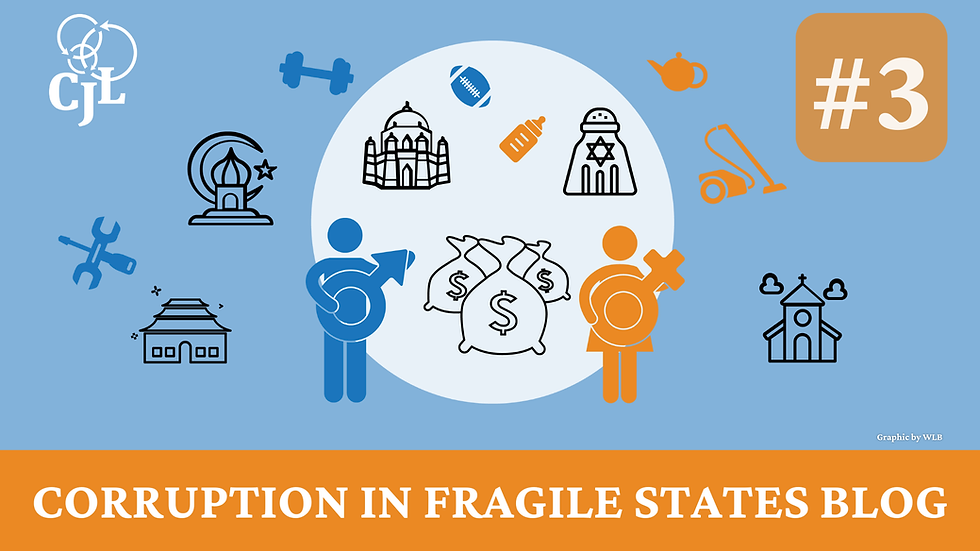How to Deal with the Complexity of Corruption: Four Recommendations for Programming
- Cheyanne-Scharbatke Church, CJL

- Jul 7, 2016
- 3 min read
By Cheyanne Scharbatke-Church

There are a number of shortcomings in the predominant approaches underlying anti-corruption programming when applied to fragile and conflict affected states. Addressing these gaps—and improving program effectiveness —requires a shift in the way we think about corruption: from a “simple” problem that is solvable through application of best practice, to a more complex understanding of corruption as embedded in a dynamic socio-political context that must be approached holistically.
Improving program effectiveness requires a shift in the way we think about corruption
Understanding corruption as a “complex” phenomenon entails significant changes in how we do analysis, strategy and program design for anti-corruption efforts. These are four key changes we recommend based on our research:

1. Conduct system-based analysis that is grounded in context
Analysis needs to illuminate the interconnections between corruption at various levels, as well as the dynamic interrelationships among the different drivers of corruption and its function in political, social and economic life. We have argued that understanding social norms, power and politics, and feedback loops is significant due to their potential to alter the impacts of anti-corruption efforts. Greater research and experimentation is needed to identify how to analyze these drivers and integrate that analysis into program design.
It should be self-evident that this analysis must be grounded in the peculiarities of each context. This is advice is ubiquitous, but rarely implemented in practice. If we continue to treat corruption as a “simple” problem, our capacity to analyze context “without prejudice” will necessarily be limited: it will be difficult to look beyond tweaking “best practice” solutions to account for context, and to open our gaze to less obvious conditions and factors that may accelerate or dampen attempts to bring about change.
2. Implement strategic, emergent design and adaptive monitoring
Anti-corruption programming design needs to engage in good design practice, including recognizing that some of the changes that are being sought are inherently emergent. This requires practitioners to do their due diligence in conducting a nuanced corruption analysis, and recognizing that there will always be areas where it is impossible to map the change pathway due to a large number of uncertainties.
Because there will always be emergent (and unpredictable) dimensions of the theory of change, as well as known and unknown feedback loops in the system, anti-corruption program design should not be viewed as a single stage in a project cycle: a design that is static will risk becoming irrelevant and ineffective.
A design that is static will risk becoming irrelevant and ineffective
As the system evolves and responds to the intervention itself, the program design should be constantly adapted through experimentation, experience, and good monitoring data. As knowledge is accumulated, the elements that were previously deemed as emergent will become clearer. At that point, good design thinking should be further applied to adapt the program to this emergent reality.
3. Pursue multi-faceted strategies
A Principal-Agent derived strategy will rarely be sufficient to positively affect corruption dynamics in foreign assistance contexts. Anti-corruption programming in these situations need to incorporate multiple strategies, including the development of new strategies for dealing with social norms; political interests, incentives and dynamics among stakeholders; informal practices and institutions (e.g., patronage networks); social and cultural rules, etc.
4. Layer strategies, and pursue strategic cooperation
Greater cooperation among different efforts—rather than “mutually exclusive” thinking about combatting corruption—is needed. Strategies should promote greater cooperation among efforts working in different sectors that are linked by the corruption system that distorts their functioning.
It is crucial to understand and pursue linkages between anti-corruption efforts
Where corruption is affected by dynamic interaction among different elements, including the presence of anti-corruption programs, it is crucial to understand and pursue linkages between anti-corruption efforts so they can amplify each other to “add up,” and avoid undermining or dampening each other’s impacts.
Read the publication on which this mini-series is based, “Taking the Blinders Off. Questioning How Development Assistance is Used to Combat Corruption.”
About the Author

Cheyanne Scharbatke-Church is Principal at Besa: Catalyzing Strategic Change, a social enterprise committed to catalyzing significant change on strategic issues in places experiencing conflict and structural or overt physical violence. As a Professor of Practice, she teaches and consults on program design, monitoring, evaluation and learning.





Comments